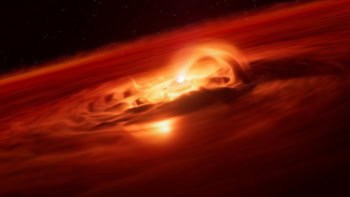
The most common form of water in the universe appears to be much more complex than was previously thought. While past measurements suggested that this “space ice” is amorphous, researchers in the UK have now discovered that it contains crystals. The result poses a challenge to current models of ice formation and could alter our understanding of ordinary liquid water.
Unlike most other materials, water is denser as a liquid than it is as a solid. It also expands rather than contracts when it cools; becomes less viscous when compressed; and exists in many physical states, including at least 20 polymorphs of ice.
One of these polymorphs is commonly known as space ice. Found in the bulk matter in comets, on icy moons and in the dense molecular clouds where stars and planets form, it is less dense than liquid water (0.94 g cm−3 rather than 1 g cm−3), and X-ray diffraction images indicate that it is an amorphous solid. These two properties give it its formal name: low-density amorphous ice, or LDA.
While space ice was discovered almost a century ago, Michael Davies, who studied LDA as part of his PhD research at University College London and the University of Cambridge, notes that its exact atomic structure is still being debated. “It is unclear, for example, whether LDA is a ‘true glassy state’ (meaning a frozen liquid with no ordered structure) or a high disordered crystal,” Davies explains.
The memory of ice
In the new work, Davies and colleagues used two separate computational simulations to better understand this atomic structure. In the first simulation, they froze “boxes” of water molecules by cooling them to -150 °C at different rates, which produced crystalline and amorphous ice in varying proportions. They then compared this spectrum of structures to the structure of amorphous ice as measured by X-ray diffraction.
“The best model to match experiments was a ‘goldilocks’ scenario – that is, one that is not too amorphous and not too crystalline,” Davies explains. “Specifically, we found ice that was up to 20% crystalline and 80% amorphous, with the structure containing tiny crystals around 3-nm wide.”
The second simulation began with large “boxes” of ice consisting of many small ice crystals packed together. “Here, we varied the number of crystals in the boxes to again give a range of very crystalline to amorphous models,” Davies says. “We found very close agreement to experiment with models that had very similar structures compared to the first approach with 25% crystalline ice.”
To back up these findings, the UCL/Cambridge researchers performed a series of experiments. “By re-crystallizing different samples of LDA formed via different ‘parent ice phases’ we found that the final crystal structure formed varied depending on the pathway to creation,” Davies tells Physics World. In other words, he adds, “The final structure had a memory of its parent.”
This is important, Davies continues, because if LDA was truly amorphous and contained no crystalline grains at all, this “memory” effect would not be possible.
Impact on our understanding
The discovery that LDA is not completely amorphous has implications for our understanding of ordinary liquid water. The prevailing “two state” model for water is appealing because it accounts for many of water’s thermodynamic anomalies. However, it rests on the assumption that both LDA and high-density amorphous ice have corresponding liquid forms, and that liquid water can be modelled as a mixture of the two.
“Our finding that LDA actually contains many small crystallites presents some challenges to this model,” Davies says. “It is thus of paramount importance for us to now confirm if a truly amorphous version of LDA is achievable in experiments.”
The existence of structure within LDA also has implications for “panspermia” theory, which hypothesizes that the building blocks of life (such as simple amino acids) were carried to Earth within an icy comet. “Our findings suggest that LDA would be a less efficient transporting material for these organic molecules because a partly crystalline structure has less space in which these ingredients could become embedded,” Davies says.
“The theory could still hold true, though,” he adds, “as there are amorphous regions in the ice where such molecules could be trapped and stored.”
Challenges in determining atomic structure
The study, which is detailed in Physical Review B, highlights the difficulty of determining the exact atomic structure of materials. According to Davies, it could therefore be important for understanding other amorphous materials, including some that are widely used in technologies such as OLEDs and fibre optics.

Immiscible ice layers may explain why Uranus and Neptune lack magnetic poles
“Our methodology could be applied to these materials to determining whether they are truly glassy,” he says. “Indeed, glass fibres that transport data along long distances need to be amorphous to function efficiently. If they are found to contain tiny crystals, these could then be removed to improve performance.”
The researchers are now focusing on understanding the structure of other amorphous ices, including high-density amorphous ice. “There is much for us to investigate with regards to the links between amorphous ice phases and liquid water,” Davies concludes.



